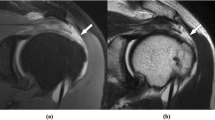Abstract
Purpose
The purpose of this paper was to evaluate if short volumetric interpolated breath-hold examination (VIBE) sequences can be used as a substitute for T1-weighted with fat saturation (T1-FS) sequences when performing magnetic resonance (MR) arthrography to diagnose rotator cuff tears.
Materials and methods
Eighty-two patients underwent direct MR arthrography of the shoulder joint using VIBE (acquisition time of 13 s) and T1-FS (acquisition time of 5 min) sequences in the axial and paracoronal plane on a 1.0-T MR unit. Two radiologists scored rotator cuff tendons on VIBE and T1-FS images separately as normal, small/large partial thickness and full thickness tears with or without geyser sign. T1-FS sequences were considered the gold standard. Surgical correlation was available in a small sample.
Results
Sensitivity, specificity, and positive and negative predictive values of VIBE were greater than 92% for large articular-sided partial thickness and full thickness tears. For detecting fraying and articular-sided small partial thickness tears, these parameters were 55%, 94%, 94%, and 57%, respectively. The simple kappa value was 0.76, and the weighted kappa value was 0.86 for agreement between T1-FS and VIBE scores. All large partial and full thickness tears at surgery were correctly diagnosed using VIBE or T1-FS MR images.
Conclusion
Fast MR arthrography of the shoulder joint using VIBE sequences showed good concordance with the classically used T1-FS sequences for the appearance of the rotator cuff, in particular for large articular-sided partial thickness tears and for full thickness tears. Due to its very short acquisition time, VIBE may be especially useful when performing MR arthrography in claustrophobic patients or patients with a painful shoulder.



Similar content being viewed by others
References
Chung CB, Corrente L, Resnick D. MR arthrography of the shoulder. Magn Reson Imaging Clin N Am 2004;2: 25–38.
Meister K, Thesing J, Montgomery WJ, Indelicato PA, Walczak S, Fontenot W. MR arthrography of partial thickness tears of the undersurface of the rotator cuff: an arthroscopic correlation. Skeletal Radiol 2004;33: 136–141.
Vanhoenacker P, Vanhoenacker F, Crevits I, Simons P, Van Dyck P. MR arthrography of the rotator cuff and capsulolabral complex. JBR-BTR 2000;83: 313–318.
Sahin G, Demirtas M. An overview of MR arthrography with emphasis on the current technique and applicational hints and tips. Eur J Radiol 2006;6: 416–430.
Palmer WE, Brown JH, Rosenthal DI. Rotator cuff: evaluation with fat-suppressed MR arthrography. Radiology 1993;9: 683–687.
Morag Y, Jacobson JA, Miller B, De Maeseneer M, Girish G, Jamadar D. MR imaging of rotator cuff injury: what the clinician needs to know. Radiographics 2006;26: 1045–1065.
Magee T, Williams D, Mani N. Shoulder MR arthrography: which patient group benefits most? Am J Roentgenol 2004;183: 969–974.
Andreisek G, Froehlich JM, Hodler J, et al. Direct MR arthrography at 1.5 T and 3.0 T: Signal dependence on gadolinium and iodine concentrations—Phantom Study. Radiology 2008;247: 706–716.
Waldt S, Bruegel M, Mueller D, et al. Rotator cuff tears: assessment with MR arthrography in 275 patients with arthroscopic correlation. Eur Radiol 2007;17: 491–498.
Ellman H. Diagnosis and treatment of incomplete rotator cuff tears. Clin Orthop 1990;254: 64–74.
Landis JR, Koch GG. The measurement of observer agreement for categorical data. Biometrics 1977;33: 159–174.
Fleiss JL, Cohen J. The equivalence of weighted kappa and the intraclass correlation coefficient as measures of reliability. Educ Psychol Meas 1973;33: 613–619.
Rofsky NM, Lee VS, Laub G, et al. Abdominal MR imaging with a volumetric interpolated breath-hold examination. Radiology 1999;212: 876–884.
Kataoka M, Ueda H, Koyama T, et al. Contrast-enhanced volumetric interpolated breath-hold examination compared with spin-echo T1-weighted imaging of head and neck tumors. AJR 2005;184: 313–319.
Wetzel SG, Johnson G, Tan AG, et al. Three-dimensional, T1-weighted gradient-echo imaging of the brain with a volumetric interpolated examination. AJNR 2002;6/7: 995–1002.
Lauenstein TC, Goehde SC, Herborn CU, et al. Three-dimensional volumetric interpolated breath-hold MR imaging for whole-body tumor staging in less than 15 minutes: a feasibility study. AJR 2002;179: 445–449.
Mermuys KP, Vanhoenacker PK, Chappel P, Van Hoe L. Three-dimensional venography of the brain with a volumetric interpolated sequence. Radiology 2005;234: 901–908.
Teefey SA, Hasan SA, Middleton WD, Patel M, Wright RW, Yamaguchi K. Ultrasonography of the rotator cuff. A comparison of ultrasonographic and arthroscopic findings in one hundred consecutive cases. J Bone Joint Surg Am 2000;82: 498–504.
Lecouvet FE, Simoni P, Koutaïssoff S, Vande Berg BC, Malgehm J, Dubuc JE. Multidetector spiral CT arthrography of the shoulder. Clinical applications and limits, with MR arthrography and arthroscopic correlations. Eur J Radiol 2008;68: 120–136.
Ganguly A, Gold GE, Butts Pauly K, et al. Quantitative evaluation of the relaxivity effects of iodine on GD-DTPA enhanced MR arthrography. J Magn Reson Imaging 2007;25: 1219–1225.
Jacobson JA, Lin J, Jamadar DA, Hayes CW. Aids to successful shoulder arthrography performed with a fluoroscopically guided anterior approach. Radiographics 2003;23: 373–378.
Matsen FA 3rd. Clinical practice. Rotator-cuff failure. N Engl J Med 2008;358: 2138–2147.
Saleem AM, Lee JK, Novak LM. Usefulness of the abduction and external rotation views in shoulder MR arthrography. AJR 2008;191: 1024–1030.
Magee T. Can isotropic fast gradient echo imaging be substituted for conventional T1-weighted sequences in shoulder MR arthrography at 3 Tesla? J Magn Reson Imaging 2007;26: 118–122.
Lee MJ, Motamedi K, Chow K, Seeger LL. Gradient-recalled echo sequences in direct shoulder MR arthrography for evaluating the labrum. Skeletal Radiol 2008;37: 19–25.
Weishaupt D, Wildermuth S, Schmid M, Hilfiker PR, Hodler J, Debatin JF. Virtual MR arthroscopy: new insights into joint morphology. J Magn Reson Imaging 1999;6: 757–760.
Author information
Authors and Affiliations
Corresponding author
Rights and permissions
About this article
Cite this article
Vandevenne, J.E., Vanhoenacker, F., Mahachie John, J.M. et al. Fast MR arthrography using VIBE sequences to evaluate the rotator cuff. Skeletal Radiol 38, 669–674 (2009). https://doi.org/10.1007/s00256-009-0677-y
Received:
Revised:
Accepted:
Published:
Issue Date:
DOI: https://doi.org/10.1007/s00256-009-0677-y




